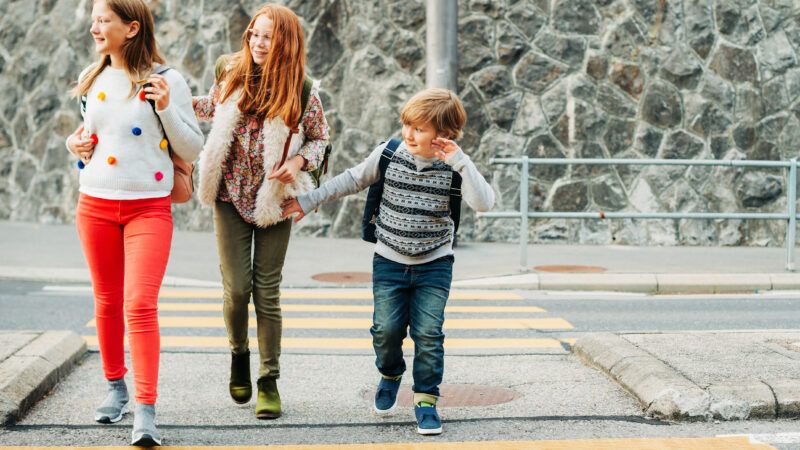'Independence Therapy' Could Revolutionize Treatment for Child Anxiety
A pilot study encouraged parents to let their kids go free-range.

A study just published in the prestigious Journal of Anxiety Disorders describes a "novel treatment" for clinically anxious kids: letting them do new things, on their own, without their parents.
In other words, letting them be Free-Range Kids.
The pilot study, by Long Island University psychology professor Camilo Ortiz and his doctoral student Matthew Fastman, focused on four kids. In his everyday practice, Ortiz would often use cognitive behavioral therapy to treat kids with anxiety. This involves exposing patients to the very thing that scares them so that they can overcome it. For instance, a person deathly afraid of dogs might be shown a picture of a dog, then stand in the same room as a dog, and finally have to pet the dog.
Independence therapy works differently.
"We didn't actually have the kids face the things they're afraid of," says Ortiz.
The patients included:
- A boy, age 13, who experienced headaches and a pounding heart and routinely assumed the "worst case scenario," that he was very sick.
- A girl, age 9, who was so anxious about attending school that she experienced "frequent shaking, stomach issues, nail biting and crying."
- A girl, age 11, who experienced "extensive worry and extensive avoidance of everyday activities out of the home." Her fear of being judged or embarrassed led to shaking and abdominal pain.
- A boy, age 10, who wouldn't go anywhere without his mom.
The independence therapy involved each family separately visiting Ortiz five times, in his office or on Zoom. At the first session, only the parents came. Ortiz discussed the value of independence and even showed them this video of me, which, Ortiz said, "has been unbelievably effective. Many parents cry."(Ortiz told me he has been aware of Free-Range Kids since I let my 9-year-old ride the subway alone and has subsequently followed the work of Let Grow.)
At that visit, Ortiz asked the parents about their biggest concern. One couple said their daughter was too scared to sleep in her own bed. Another said their son wouldn't go up or downstairs in their home without them.
On the next visit, the child accompanied the parents. But without mentioning the big fear, Ortiz talked up independence and asked the kids what they'd like to start doing on their own. Despite their anxiety, they wanted to walk home from school, play chess in the park, take public transportation, and many other things. "OK," Ortiz told each child, "your assignment is to do one 'independence activity' a day for the next four weeks." The parents' assignment was to let them.
And yet, Ortiz confides, "The whole time I was rooting for things to go wrong." It's when a person goes from "I can't handle this!" to "Whoa—I handled it!" that the biggest growth occurs, he says.
For one of her independence activities, the girl afraid to sleep in her own bed took a city bus—and missed her stop. She was so upset that she actually talked to a stranger: the person next to her. That person told her to get off and walk two blocks back. She accomplished this, and the results were incredible.
"During the last week of treatment, unprompted," Ortiz wrote in the study, the girl "slept in her bed after never having made it through a night previously." And then she kept doing it.
Similarly, while out on an independent walk, the boy terrified about his health "really had to pee," Ortiz says. He relieved himself on the side of a building. Later, when Ortiz and the boy discussed this during a session, "we had a good laugh, but he actually learned something: Life can be messy, and it's OK."
Being psychologically flexible is one of the most important factors for predicting a good life.
In the end, the kids' anxieties markedly decreased. That was true even for the one patient who didn't finish the treatment. After two sessions, she was already "over the hump," said her parents, who reported that "she requested to stay home alone for four hours, went into a restaurant to ask for a table, babysat three kids, and organized an online art auction."
In psychological terms, it seems the kids' confidence spread from the new things they were doing to the things they'd been too scared to do. This mirrors a recent study of people afraid of both heights and spiders. Treated for one, they became less afraid of the other.
If further studies of independence therapy show this kind of success—Ortiz is seeking funding—it could prove a valuable alternative to cognitive behavioral therapy for three reasons. One, it seems to require fewer sessions, which makes it cheaper. Two, it doesn't require much training and could be done in schools. Three, it doesn't require the parents, kids, or therapists themselves to deal with the unpleasant, triggering fear.
"This is a pretty big finding—that you don't have to actually treat directly the thing someone is afraid of to make that thing better," says Ortiz.


Show Comments (22)